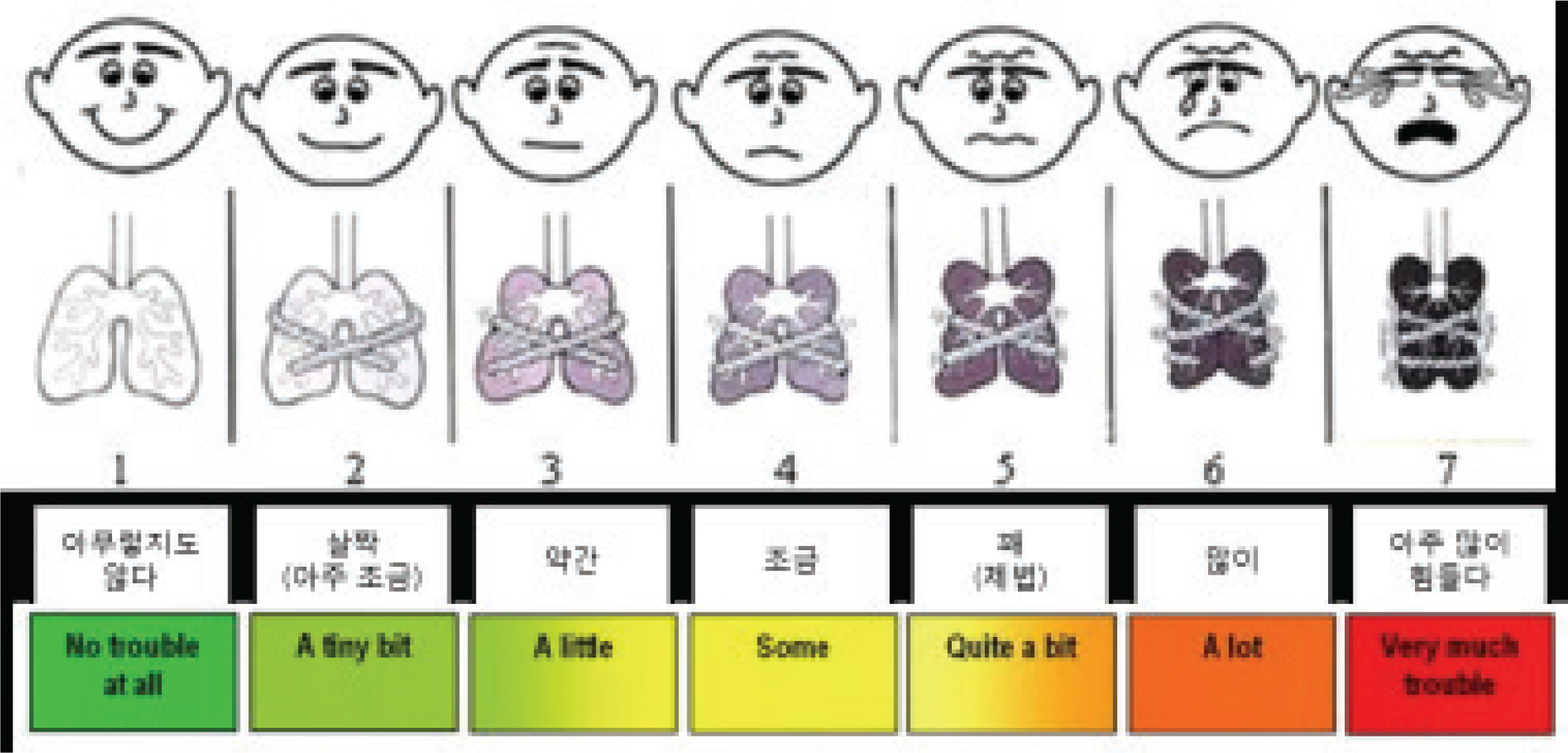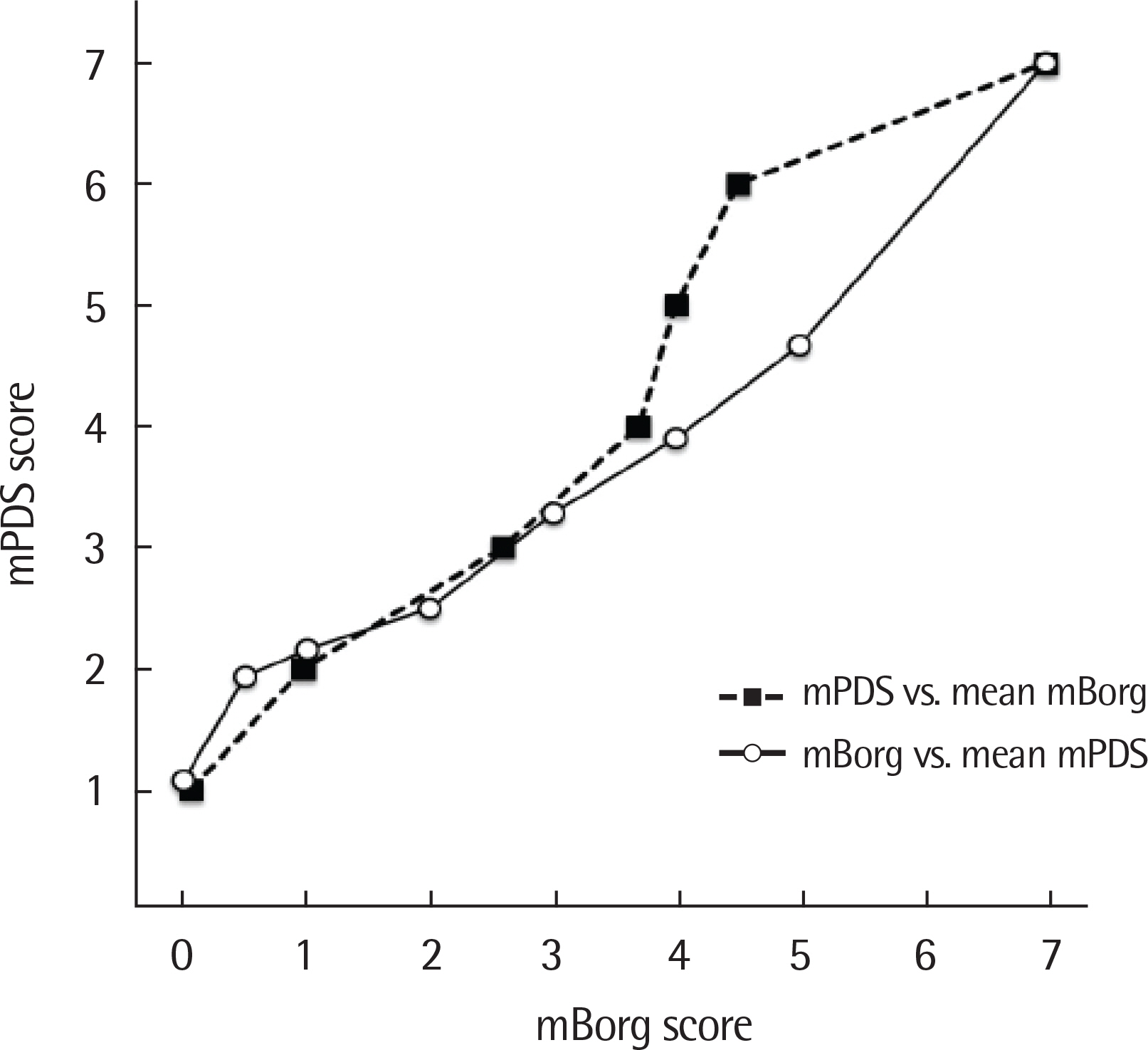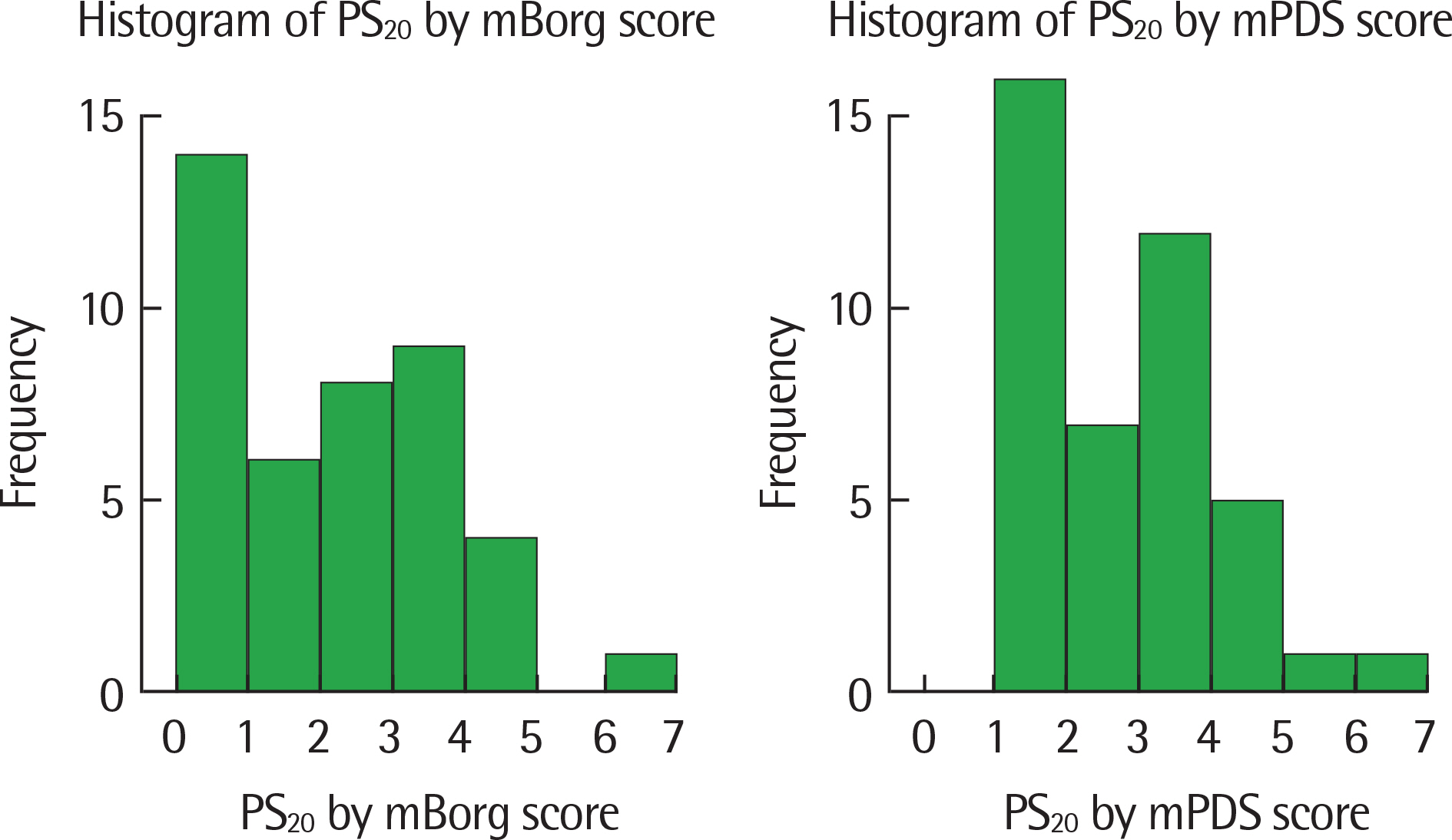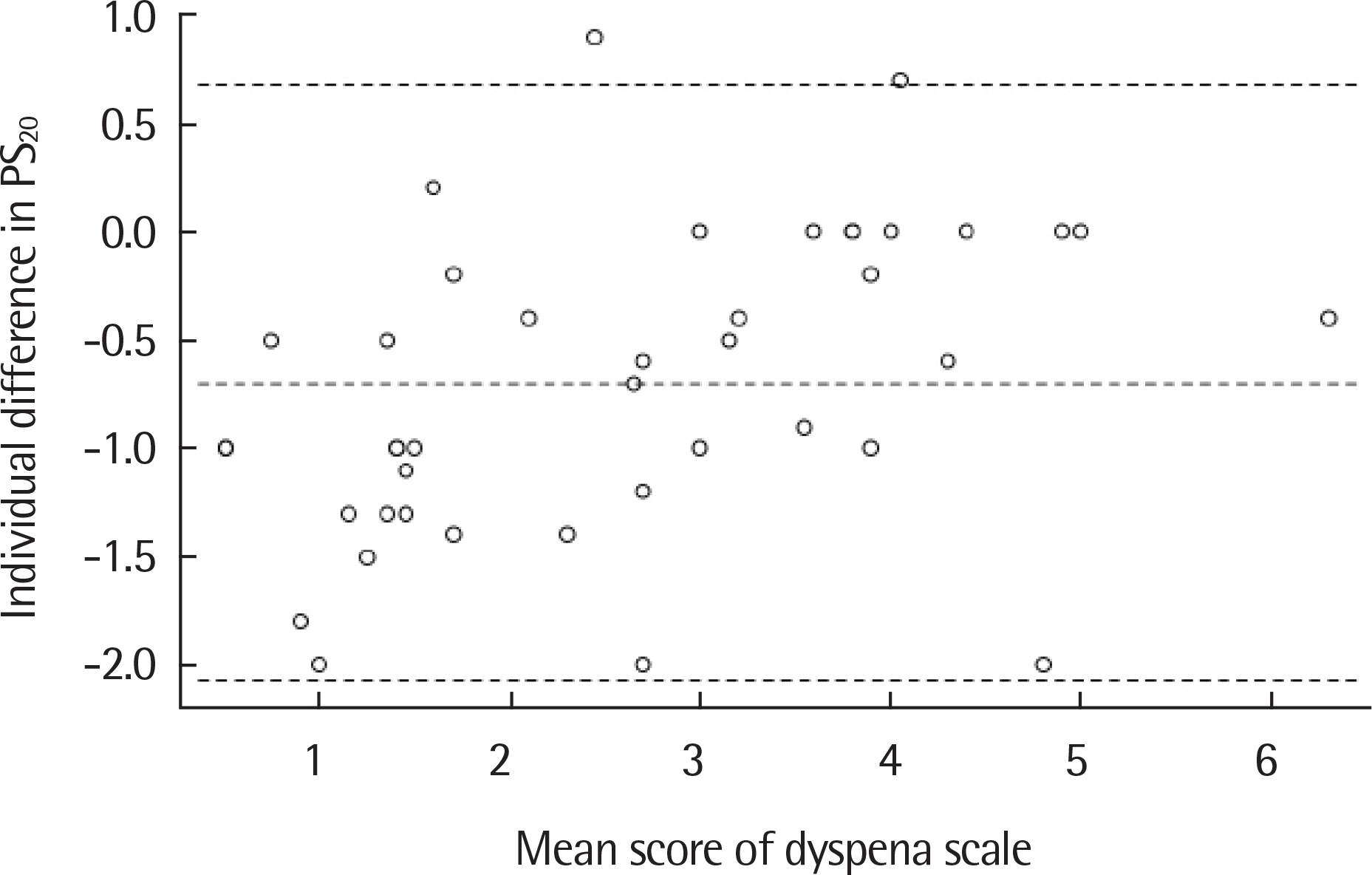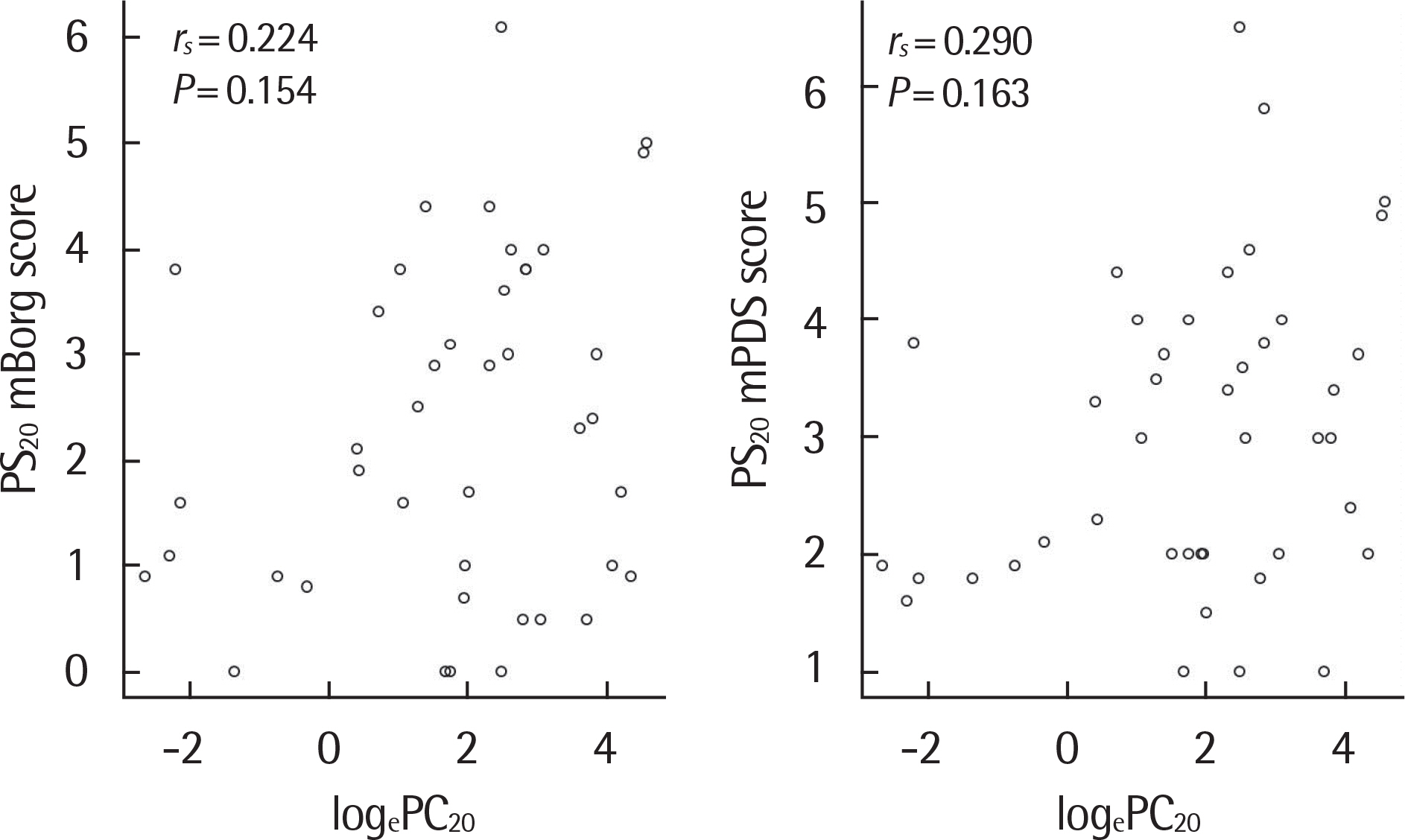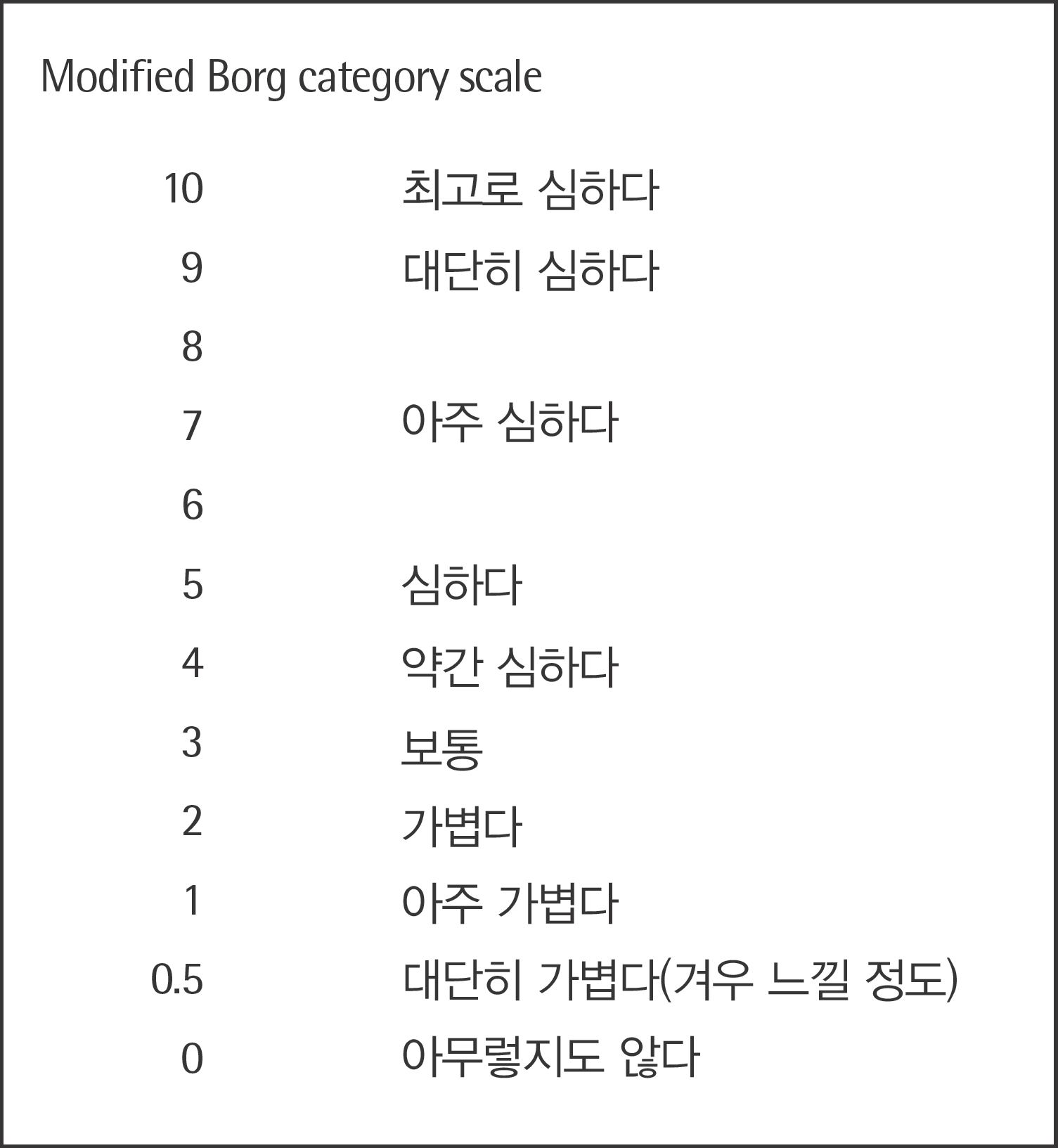Allergy Asthma Respir Dis.
2017 Sep;5(5):262-268. 10.4168/aard.2017.5.5.262.
Comparison on the profiles of a modified Borg scale and the pediatric dyspnea scale during an induced bronchoconstriction in children with clinical asthma
- Affiliations
-
- 1Department of Pediatrics, Seoul National University College of Medicine, Seoul, Korea. flubber224@gmail.com
- 2Department of Pediatrics, College of Medicine, Seonam University, Gwangju, Korea.
- 3Department of Pediatrics, Korean Cancer Center Hospital, Seoul, Korea.
- KMID: 2392401
- DOI: http://doi.org/10.4168/aard.2017.5.5.262
Abstract
- PURPOSE
Dyspnea is the cardinal symptom of asthma, but it is difficult to quantify clinically. Although modified Borg (mBorg) scale has been successfully used in adult, but there has been some difficulties to apply in children. Recently, Pediatric Dyspnea Scale (PDS) was adequately designed and has been widely used. The aim of this study is to compare 2 evaluating scales of dyspnea provoked by induced-bronchoconstriction in childhood asthma.
METHODS
Seventy-three clinically suspected children with asthma were enrolled in this study. Each "˜fractional exhaled nitric oxide (FeNO)' was documented. Forced expiratory volume in 1 second (FEVâ‚), mBorg score and PDS score were recorded during methacholine provocation test.
RESULTS
Mapping using canonical plot demonstrated global similarity between 2 scales with some distinctive features. Whereas mBorg score showed more diverse categories in low level of dyspnea, PDS score did in medium level of it. A distribution of dyspnea perception score at a 20% decrease in FEVâ‚ relative to baseline (PSâ‚‚â‚€), a perception score of dyspnea at 20% fall in FEV1 of 2 scales represented similar wide, biphasic feature. Statistical relevance was verified with spearman correlation (R(s)=0.903, P<0.001) and Bland-Altman analysis. PSâ‚‚â‚€ of both scores and FeNO had no statistical relationship. While relationship between PS20 by mBorg score and the concentration of methacholine at 20% fall in FEVâ‚ (PCâ‚‚â‚€) was not significant (R(s)=0.224, P=0.154), that between PSâ‚‚â‚€ by PDS and PCâ‚‚â‚€ was weak positive (R(s)=0.29, P=0.063).
CONCLUSION
PDS had similar pattern to assess the dyspnea with the mBorg scale suggesting adequacy of PDS in evaluating pediatric clinical asthma. We expect these scales to help clinical practice in complementary ways.
MeSH Terms
Figure
Reference
-
1. Dyspnea. Mechanisms, assessment, and management: a consensus statement. American Thoracic Society. Am J Respir Crit Care Med. 1999; 159:321–40.2. National Asthma Education and Prevention Program. Expert Panel Report 3 (EPR-3): Guidelines for the Diagnosis and Management of Asthma-Summary Report 2007. J Allergy Clin Immunol. 2007; 120(5 Suppl):S94–138.3. Borg GA. Psychophysical bases of perceived exertion. Med Sci Sports Ex-erc. 1982; 14:377–81.
Article4. Adams L, Chronos N, Lane R, Guz A. The measurement of breathlessness induced in normal subjects: validity of two scaling techniques. Clin Sci (Lond). 1985; 69:7–16.
Article5. Wilson RC, Jones PW. A comparison of the visual analogue scale and modified Borg scale for the measurement of dyspnoea during exercise. Clin Sci (Lond). 1989; 76:277–82.
Article6. Seo IK, Choi IS, Kim SH, Han ER. Variation of dyspnea perception in re-peatedly hospitalized patients with asthma. Korean J Asthma Allergy Clin Immunol. 2011; 31:20–6.7. Khan FI, Reddy RC, Baptist AP. Pediatric Dyspnea Scale for use in hospitalized patients with asthma. J Allergy Clin Immunol. 2009; 123:660–4.
Article8. Miller MR, Hankinson J, Brusasco V, Burgos F, Casaburi R, Coates A, et al. Standardisation of spirometry. Eur Respir J. 2005; 26:319–38.9. Crapo RO, Casaburi R, Coates AL, Enright PL, Hankinson JL, Irvin CG, et al. Guidelines for methacholine and exercise challenge testing-1999. This official statement of the American Thoracic Society was adopted by the ATS Board of Directors, July 1999. Am J Respir Crit Care Med. 2000; 161:309–29.10. Kang KW, Choi IS, Park SC, Lim H, Jang AS. B lunted dyspnea perception in severe asthmatics. J Asthma Allergy Clin Immunol. 1999; 19:173–80.11. Burdon JG, Juniper EF, Killian KJ, Hargreave FE, Campbell EJ. The perception of breathlessness in asthma. Am Rev Respir Dis. 1982; 126:825–8.12. Lansing RW, Gracely RH, Banzett RB. The multiple dimensions of dyspnea: review and hypotheses. Respir Physiol Neurobiol. 2009; 167:53–60.
Article13. Lebowitz MD, Thompson HC, Strunk RC. Subjective psychological symptoms in outpatient asthmatic adolescents. J Behav Med. 1981; 4:439–49.
Article14. Baron C, Lamarre A, Veilleux P, Ducharme G, Spier S, Lapierre JG. Psy-chomaintenance of childhood asthma: a study of 34 children. J Asthma. 1986; 23:69–79.
Article15. Chetta A, Castagnaro A, Foresi A, Del Donno M, Pisi G, Malorgio R, et al. Assessment of breathlessness perception by Borg scale in asthmatic patients: reproducibility and applicability to different stimuli. J Asthma. 2003; 40:323–9.
Article16. Boulet LP, Leblanc P, Turcotte H. Perception scoring of induced broncho-constriction as an index of awareness of asthma symptoms. Chest. 1994; 105:1430–3.
Article17. Chetta A, Gerra G, Foresi A, Zaimovic A, Del Donno M, Chittolini B, et al. Personality profiles and breathlessness perception in outpatients with different gradings of asthma. Am J Respir Crit Care Med. 1998; 157:116–22.
Article18. Nuijsink M, Hop WC, Jongste JC, Sterk PJ, Duiverman AE. Cato Study Group. Perception of bronchoconstriction: a complementary disease marker in children with asthma. J Asthma. 2013; 50:560–4.
Article19. Motomura C, Odajima H, Tezuka J, Harada J, Okada K, Nishima S. Perception of dyspnea during acetylcholine-induced bronchoconstriction in asthmatic children. Ann Allergy Asthma Immunol. 2009; 102:121–4.
Article20. Janssens T, Verleden G, De Peuter S, Van Diest I, Van den Bergh O. Inac-curate perception of asthma symptoms: a cognitive-affective framework and implications for asthma treatment. Clin Psychol Rev. 2009; 29:317–27.
Article
- Full Text Links
- Actions
-
Cited
- CITED
-
- Close
- Share
- Similar articles
-
- A Comparative Study between External Resistive Loads to Breathing and Induced Bronchoconstriction on Dyspnea Perception in Asthma
- Exercise induced delayed bronchoconstriction in children with asthma
- A Comparative Study between External Resistive Loads to Breathing and Induced Bronchoconstriction on Dyspnea Perception in Asthma
- B lunted dyspnea perception in severe asthmatics
- Dyspnea Perception During Induced Bronchoconstriction Is Complicated by the Inhaled Methacholine in Children With Clinical Asthma

